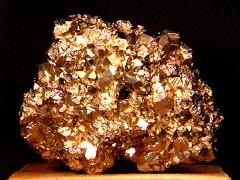Fool's gold may be new photovoltaic material
 Fool’s gold might not just be for fools after all. Researchers at the University of California, Irvine, are working on repurposing this plentiful waste product into thin-film photovoltaics.
Fool’s gold might not just be for fools after all. Researchers at the University of California, Irvine, are working on repurposing this plentiful waste product into thin-film photovoltaics.
Why pyrite? It’s abundant, and it’s now considered waste—so it’s cheap. And, according to the research, published in the Journal of the American Chemical Society, “In principal, all of U.S. primary power demand could be met with 10 percent of the pyrite that is disposed annually as mining waste in six U.S. states alone.”
The researchers, led by Matt Law, an assistant professor of chemistry at the university, are developing pyrite iron persulfide (i.e., fool’s gold) nanocrystals that can serve as a semiconductor in photovoltaics.
“Pyrite would be used to replace the light-absorbing semiconductor layer,” Law said. He said it would replace silicon or other semiconductors like cadmium telluride.
The lab already has produced some solar cells with the technology.
“But the main goal of the project at this stage is to understand the fundamental electronic properties of pyrite thin films,” Law said.
This isn’t the first time pyrite has been looked at a potential semiconductor for solar cells.
“We are not the first to work on pyrite for solar electricity,” he said. “The Tributsch group in Germany did the groundbreaking work in the 1980s and 1990s.”
While pyrite has qualities that make it an ideal photovoltaic semiconductor, including its quantum efficiencies and photocurrents, it has a low photovoltage, according to the article.
“The low photovoltage is attributed to sulfur vacancies in the bulk and at the surface that generate electronic states within the band gap. Enhancing the photovoltage and efficiency of pyrite cells requires basic research on the growth, surface passivation, and structural and electronic characterization of pyrite films,” the article explained.
The goal of the research at the university is to increase the voltage of pyrite.
“Our goal is to use modern tools, new synthetic approaches, mathematical models, and a multi-disciplinary research team to fix pyrite's low voltage,” Law said.
According to the research, Pyrite nanocrystals are a potential solution. The team said nanocrystals are, “Particularly appealing because of the prospect of fabricating inexpensive, large-area photovoltaics by the roll-to-roll deposition of nanocrystal solar ink or paint on flexible substrates.” It added, such photovoltaics “processed from solution may offer excellent manufacturing scalability at very low cost relative to conventional single-crystal and thin-film approaches.”
Image courtesy of Carnegie Mellon.



